Prevent Tooth Enamel Problems During Braces with Proper Orthodontic Care
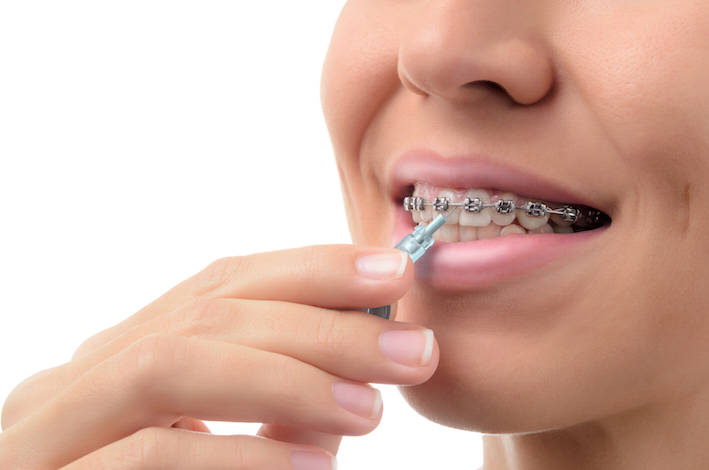
There are many oral health problems that can happen with braces if you are not focused on your orthodontic care and brushing/flossing of your teeth. Your diet can damage your teeth during your orthodontic treatment, which is why we want you to avoid certain foods and drinks. Your diet can damage your teeth during your orthodontic treatment, which is why we want you to avoid certain foods and drinks. Overly acidic or sugary foods and drinks can lead to tooth decay and acid erosion that harms your tooth enamel. We can help you to know what foods and drinks to avoid so you don’t have dental problems during your time with braces!
Increased Risk of Tooth Decay When With Braces
Braces provide patients with a spectacular tool for straightening smiles and correcting jaw problems that impact self confidence and overall oral wellness. Technology has improved over the years allow for less and less of an apparatus on the tooth enamel, but, nonetheless, there is still an apparatus sitting on your teeth for the duration of your treatment. Unless you are wearing removable Invisalign aligners for your orthodontic treatment, your apparatus will consist of wires and brackets. Your wires and brackets are fundamental to the treatment process, but they also can make it difficult to remove food particles that get stuck under, between and in your brackets and wires. If this food is left to fester, the acidic content of the food can eat away at your tooth’s vital tooth enamel.
Combat this type of tooth decay by using the tools your orthodontist recommends for cleaning your teeth. This includes regular brushing, an interdental brush, floss (and floss threaders) and possibly a water flosser to help you use the force of water to rid your mouth of stuck debris.
Acidic Foods and Drinks Erode Tooth Enamel
When it comes to taking care of your teeth with braces, one of the best things you can do is pay attention to what you are putting in your mouth. Thinking about what is coming in contact with your pearly whites can protect your teeth from erosion and decay.
Certain foods and beverages are more acidic (eroding) than others. Low acid foods are better for your teeth even though some of their high acidic counterparts are good for your body. During orthodontic treatment, focus on eating foods that are BOTH good for your body AND your teeth.
Less tooth-friendly foods and drinks include: apples, cherries, oranges, peaches, pears, plums, pineapples, raspberries, tomatoes, pickles, soft drinks, fruit drinks, vinaigrette dressings, BBQ sauces and salsas.
More tooth-friendly foods and drinks include: bananas, mangoes, melons, carrots, cucumbers, lettuce, beets, milk, water, meat, poultry, seafood, eggs, crackers, soups and pasta.
Orthodontic Care: Cleaning Teeth at Home
If ever there was a time to skimp on your oral hygiene it is NOT when you have braces. Diligent home care can make a significant difference in your smile results post-orthodontic treatment. Here are three steps to follow to help you find success:
- Brush after every meal. Because your braces can easily attract and trap food particles, brushing after each meal can help prevent staining and reduce the potential for bacteria buildup. To brush teeth with a regular soft brush, brush down from the top, then up from the bottom on each tooth with a bracket.
- Use a threadable floss or a floss threader. (If using a floss threader, thread regular floss through the eye of the threader, the same way you would with a sewing needle and thread.) Using the small or the pointed end, insert the floss or floss threader between the teeth, but below the archwire. Gently move it back and forth until it is able to thread the floss between the teeth. Once in place, you can floss the two teeth on either side of where you have inserted the floss, taking care not to apply force or pressure against the archwire. Repeat between all teeth.
- Use a proxabrush (interdental brush). After brushing with a toothbrush, use a proxabrush, commonly referred to as a “Christmas tree brush,” to clean between each bracket. Place the proxabrush between two brackets, below the archwire, brushing up and down. After several strokes, repeat this motion by inserting the brush from the opposite side (either down from the top or up from the bottom).
If you are having ANY difficulties cleaning your teeth with these above tools, contact our office so we can help!
Schedule an Orthodontic Care Consultation to Protect Your Tooth Enamel
Your time with braces will come and go in a flash, although you might not believe that in the beginning. The efforts you make from day one with your braces to protect your tooth enamel will show in the results of sparkling, white, strong, healthy teeth. Our friendly staff at Belmar Orthodontics is available to train you in methods and tools for keeping your teeth clean and strong. Make sure to keep your regular cleaning and check-up appointments so we can examine your teeth and make suggestions for improvements. Make an appointment by contacting our office today at 303.225.9016. We are excited to meet you and help you reach your smile goals!
Cavity Treatment During Braces
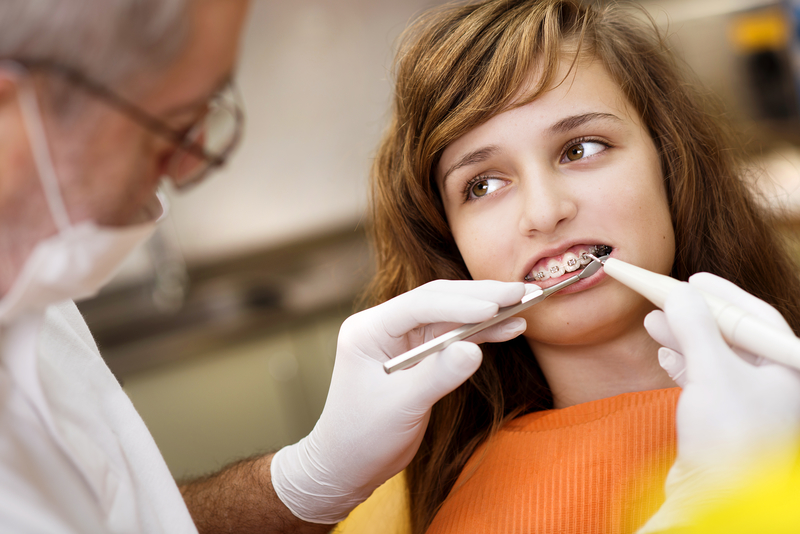
Did you know that an orthodontist and a dentist are not the same? Only a dentist can help with cavities, gum disease and more, while only an orthodontist can straighten your teeth in a certain way. A patient’s time with braces is a time when cavities happen very quickly, because the teeth are harder to clean. To prevent cavities during your time with braces, it is vital that you continue to see a dentist. If you do happen to get a cavity, find out what that cavity treatment will look like!
Proper Oral Hygiene
The American Dental Association recommends that every patient brush their teeth at least twice a day to avoid tooth decay. Brushing after every meal is even better for avoiding plaque buildup that leads to decay. Every patient should also floss their teeth at least once a day. Using fluoride toothpaste is best, because fluoride helps coat the teeth in a protective layer that prevents decay and keeps tooth enamel stronger. Patients can also benefit from mouthwash, as it can kill bacteria that would otherwise create plaque.
However, these recommendations are for people that don’t have braces. Every single person—children, teens and adults—should follow these recommendations. Infants should not use fluoride or mouthwash, but their child toothpastes generally have safe amounts of fluoride in them. If you are a patient that is receiving orthodontic care via braces, you have to go the extra mile with your oral hygiene. That means more frequent brushing, more flossing and watching what you eat.
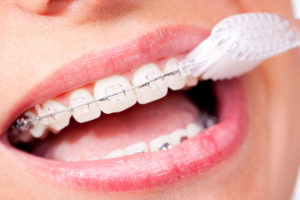
Taking Care of Braces
Braces can be tricky to clean. However, their design provides the best and quickest way for you to straighten your teeth, which is why traditional metal braces have been around for so many decades. Metal braces, ceramic braces and lingual braces all have a brackets-and-wires design.
However, with braces, you must be meticulous with cleaning them or you will have food and plaque get stuck places. If you don’t unstick those substances, they will quickly erode your tooth enamel and cause decay around your appliances. This can happen on every tooth as well.
Follow these tips for cleaning your braces:
- Brush after every single meal. This reduces staining and bacteria buildup. Use a regular soft-bristled brush and brush down from the top, then up from the bottom. Brush in all different directions to dislodge food.
- Use a threadable floss or a floss threader. Both will require that you thread the floss through each space between your teeth. You will have to go under the wire to do this, and it will take slightly longer than normal flossing. This is one of the most important oral hygiene recommendations to follow!
- Use helpful tools. A proxabrush is a small braces brush that can help unstick foods. It looks like a tiny Christmas Tree brush. A waterpik is also helpful. This is a tool that helps blast away food particles with a stream of water.
Tooth Decay with Braces
Many children and teens skip flossing or brushing here and there. Every time you skip on an oral hygiene habit, it increases your risk for tooth decay—or cavities—with braces. Your time with braces is one where you have to be super careful about your oral health. Most people picture their beautiful smile after getting their braces off, but they don’t think about cavities and tooth erosion. You can end up with tooth decay and parts of your teeth that have eroded due to your oral hygiene habits with braces.
Nobody wants to spend 18-24 months perfecting their teeth only to be disappointed in their smile. That’s why oral hygiene is so important. Tooth decay happens rapidly, and it can happen where the brackets are bonded to your teeth and in-between your teeth because it is harder to floss. Normally, you would simply visit the dentist and have your cavity removed and filled. However, cavity treatment is a bit different with braces.
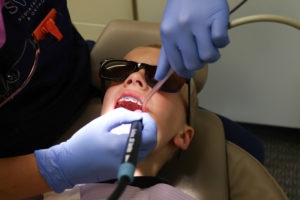
Cavity Treatment with Braces
Cavity treatment is slightly harder if you have braces, but not impossible. Generally, decay happens between teeth cracks and around brackets and wires. If you have tooth decay that is in a tricky spot, we can remove your wire so that a dentist can provide you with a proper cavity treatment. You will have to have your appointments scheduled close together (dentist and orthodontist) so that you can get your cavity filled and your wire replaced.
In severe cases of tooth decay, we may have to remove a bracket from the tooth if it interferes with the dental work that needs to be done. We only do this in certain cases, and we replace the missing part as soon as possible so your teeth don’t move. Cavity treatment—with taking out the tooth decay and filling it—is the same with braces as it is without, only you have to work around orthodontic appliances if you have braces. Always let us know if you have tooth sensitivity, sharp (and even mild) pain when chewing and if you have sensitivity to hot or cold foods. This signals that there may be a more severe cavity.
Prevent Cavity Treatment
The goal of every patient—old and young—is to avoid tooth decay altogether. If you do, you’ll never have to worry about cavity treatment with braces. If your decay is small and in a tricky spot, you may have to wait until your braces are off to receive your cavity treatment. That might make your cavity grow larger, which is something you don’t want. Always see the dentist to check your mouth for tooth decay before you receive orthodontic treatment. This can avoid many problems in the future.
If you are prone to getting cavities or you have weak enamel, consider receiving Invisalign treatment instead of getting brackets and wires. This will help you avoid problems with cavities and needing to get cavity treatment. If you have tooth pain or want to learn more about cavity treatment with braces, call Belmar Orthodontics today at (303) 225-9016!
Foods and Drinks that Hurt Your Teeth

Braces is an amazing time to get a straighter, more beautiful smile. However, wearing braces on your teeth make them much harder to clean than they were before. This is especially true when it comes to certain foods and drinks. We have a list of foods that you should avoid during your orthodontic treatment because those foods stick to the teeth. You never want food to stay stuck in your braces, as this leads to tooth decay and demineralization. We can help you to know what foods and drinks to stay away from during your orthodontic treatment. We can also help you to know how to properly clean your teeth so you don’t have to worry about tooth decay as your teeth get straighter. Avoid foods and drinks that hurt your teeth so you can have a beautiful smile once those braces come off!
Foods to Avoid
Braces bring many changes for 18-24 months. One of those is avoiding foods that could hurt your teeth. Hard foods, sticky foods and foods high in sugar should be avoided. Eating foods high in sugar increases your risk of cavities, which you want to avoid. Also avoid:
- Hard candy
- Chips
- Ice
- Apples
- Crusty bread
- Nuts
- Popcorn
- Corn on the cob
- Carrots or other hard vegetables
- Gum (this is a big one)
- Caramel
- Sugar Daddies and similar candies
- Skittles
- Tootsie Rolls
- Starburst
- Licorice
- All types of taffy
You will also want to avoid carbonated and sugary drinks. Sugary drinks also increase your risk for tooth decay, and the last thing you want with braces are cavities. Carbonated drinks contain carbonic acid, which erodes your tooth enamel and can lead to demineralization. If your teeth demineralize, they become weaker and could even have spots where they simply erode away. Limit your citric fruits (like oranges or lemons) as well as citric drinks, as these also contain acids that will hurt your teeth and erode them.
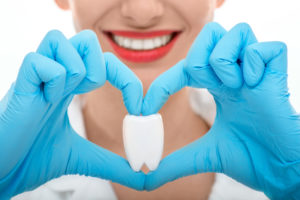
Why to Avoid These Foods
We can give you lists of foods to avoid, but it’s also best to explain why you should avoid these types of foods.
- Hard Foods – Your teeth and even you braces appliances are very hard, however, they are not unbreakable. Even without braces, you want to be careful about eating hard foods, as you could break a tooth. With braces, you could break a bracket or wire or have it come right off the tooth, which is something you don’t want. The hard candies and foods we have listed on foods to avoid are ones that we have seen hurt your teeth time and again. If you must eat hard foods (or if you really want to), cut up foods such as apples into small, bite-sized pieces. However, you should avoid nuts and popcorn hulls at all costs, as there really is no good way around eating these without the chance that you could hurt your teeth or brackets. Without braces, you want to still avoid chewing on ice or hard candies, as you could break or crack a tooth. Suck on hard foods instead.
- Sticky Foods – Sticky foods can sometimes be worse than hard ones and could even hurt your teeth more if you think about the tooth decay they can cause. Even though many sticky foods (such as gum or caramel) are soft, they are so hard to get out of your brackets. These types of foods get stuck and stay stuck long after you’ve finished eating them. Then, you have to spend a lot more time trying to brush and pick at your brackets to remove these foods. If you don’t, sticky candies and foods can sit in your brackets and wires, eroding your tooth enamel and causing tooth decay. If you eat these foods a lot, you could end up with parts of your teeth that are cratered or worn away when you get your braces off.
Cleaning Your Braces
Some tips to follow to avoid plaque buildup and tooth decay include:
- Brushing after every meal. Your braces can easily attract and trap food particles. Instead of brushing just twice a day as the American Dental Association recommends, we suggest brushing after every meal. Brush your teeth with a regular, soft-bristled brush. Brush down from the top and then up from the bottom on each tooth with a bracket to fully dislodge all food.
- Use a floss threader. You can either buy floss threaders or threadable floss. This is floss that you thread through the small spaces between teeth. You pull the floss through and then floss under your wires. The more you practice this, the quicker and easier it becomes. Don’t ever skip flossing just because it takes a bit longer, and floss at least twice a day.
- Use a proxabrush and/or waterpik. A proxabrush is a small christmas-tree brush that you can use to dislodge and clean food easily from brackets. A waterpik is a tool that shoots water in your mouth and brackets to dislodge food.
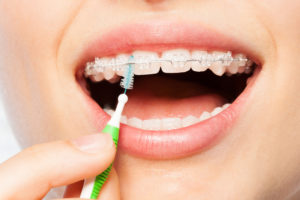
Avoid Actions that Hurt Your Teeth
Follow our guidelines for foods to avoid and what to do if you want to eat those foods. Take meticulous care of your teeth during your time with braces and you will thank yourself for the beautiful smile you’ll have when you get those braces off. If you have questions about foods or other topics that we haven’t covered, call Belmar Orthodontics at (303) 225-9016 for all of your questions!
Dental Care during Braces
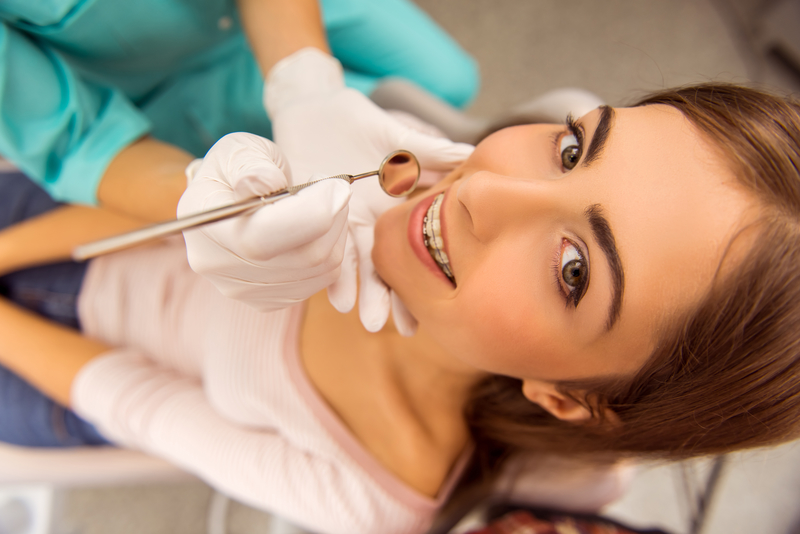
An orthodontist has been to dental school and is skilled enough to spot gum and teeth problems. However, seeing an orthodontist is not enough to keep your teeth healthy. During your time receiving braces, it’s also important to keep seeing a dentist for cleanings, exams and dental treatments. Learn why dental care and oral hygiene is important during your time with braces and how it can help you have a better smile after your braces!
Caring for Metal Braces
Your dental care during braces will depend on the type of braces you receive. If you choose metal braces, brackets and wires in your mouth make it easier for food particles to get stuck. This quickly leads to dental issues if proper care is not taken. You have to be meticulous about cleaning away plaque and stuck food particles so that you avoid tooth decay and demineralization of your tooth enamel. You do this by:
- Brushing after every meal. Your braces easily trap food particles every single time you eat. Brushing after each meal can prevent staining and reduce the potential for bacteria buildup. When brushing, make sure you have a regular, soft-bristle brush. Brush down from the top, then up from the bottom on each tooth that has a bracket.
- Using a threadable floss or floss threader. You will quickly notice that you can’t floss the conventional way with metal braces because the archwire is in the way. If you use a floss threader, thread regular floss through the eye of the threader like you would a sewing needle and thread. Or, using threadable floss, insert the small or pointed end in between your teeth, pulling it through. Once in place between your teeth, you can floss the two teeth on either side of where you have inserted the floss, taking care not to apply force or pressure against the archwire. Repeat between all teeth.
- Using a proxabrush. This is a small brush that looks like a Christmas tree. Place the proxabrush between two brackets, below the archwire, brushing up and down. After several strokes, repeat this motion by inserting the brush from the opposite side (either down from the top or up from the bottom).
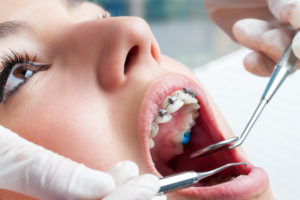
Dental Care with Other Braces
There are other types of braces besides metal braces. At our office, we also offer Invisalign, lingual braces and ceramic braces.
- Ceramic braces – Care for ceramic braces is the same as for traditional metal braces. This is because the design of these braces are the exact same, except they are made out of white, ceramic material.
- Lingual braces – These braces consist of brackets and wires that are placed on the tongue-side of your teeth (meaning behind the teeth). You will have to be more careful with brushing and flossing your teeth, as you won’t be able to see the brackets and wires as well. However, cleaning is very similar to how you would clean metal braces. With flossing, floss threaders will become your best friend, and you’ll want to be meticulous with this because food can get stuck more often with the braces being inside your mouth by your tongue.
- Invisalign – This orthodontic appliance is completely different than the other options you have. Invisalign is a series of transparent aligners that you switch out every week. The benefit of these aligners is that you can easily remove them, and brush and floss your teeth like normal. No brackets, wires or lengthy flossing session. When you take the aligners out, rinse them to get the saliva off of them. Then soak them in a retainer/braces cleaner. An example is Retainer Brite or denture cleaner.
Do You Need to See a Dentist?
Did you know that an orthodontist must complete dental school. In order to practice orthodontics, they need to complete a 4-year bachelor’s degree followed by 4 years of dental school. After that time, an orthodontist will continue 2-3 years of additional training and schooling to practice orthodontics. Therefore, an orthodontist knows what a dentist knows when it comes to your oral health. However, one point that we want to stress is that you need to continue seeing the dentist during your time with braces.
An orthodontist is skilled at treating issues with your oral health, however, an orthodontist is in charge of correcting bite and alignment. A dentist is the one that will need to correct problems with tooth decay and gum disease. Even though an orthodontist has received the same training, their profession is to not to fill cavities or do root canals unless their practice does both. During your time with braces, you must continue receiving dental care from a dentist. Braces raise your risk for tooth decay and gum disease
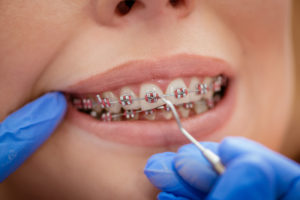
Dental Care during Your Time with Braces
Your dental care during braces will depend on the type of braces you receive. Many patients choose traditional metal braces for straightening their teeth. No matter what orthodontic option you choose, it is particularly important to maintain great dental care through attention to proper oral hygiene. If you don’t know what that proper hygiene routine looks like, we can help you. As always, if you have any questions about braces care or maintenance, please do not hesitate to contact our office. We are here to help you reach your goals and to keep your mouth healthy. For help caring for your braces, or if you are finding certain oral hygiene tasks difficult, call Belmar Orthodontics at (303) 225-9016!
Retaining a Straight Smile for Life

A straight smile is something that millions of people strive for. In fact, more than 4.5 million Americans wear braces each year to achieve that straighter smile. Not only are there aesthetic benefits of a more beautiful smile, but a straighter smile also helps you to avoid oral health issues. For children, we can correct bite and alignment problems that make biting, chewing, speaking, and breathing difficult. For adults, we can correct these issues as well as make the permanent teeth straight. This can be done through traditional metal braces, lingual braces, clear ceramic braces, and Invisalign transparent aligners. Once you have a straight smile though, you must take care of your oral health to keep that smile straight. We can help you to know the benefits of a straighter smile and how you can keep it straight throughout life!
Straightening Your Teeth
In ages past, straightening your teeth was much more difficult than it is today. Instead of only offering traditional metal braces, we give our patients several orthodontic options to get that straight smile they’ve always wanted. Traditional metal braces are still the economical and most popular option amongst patients. This is the tried and true method of achieving a straight smile, and is what most people think of when they picture braces. This design consists of metal brackets attached to the front and center of every tooth, where an archwire will go through each bracket. At each appointment, this wire is adjusted and the teeth get straighter and straighter.
Your Options
We also offer lingual braces, ceramic braces and invisalign treatment:
- Lingual Braces – Think of these braces as metal brackets attached to the inside of your teeth. They are generally more gold in appearance and instead of a bracket attached to each tooth, there is a custom-made metal piece attached to the inside of each tooth. There is a bracket and a wire just like with traditional metal braces, but the entire appliance is on the tongue-side of your teeth. This option is great for teens and adults who want a straight smile without people seeing their appliance.
- Clear Ceramic Braces – Made of ceramic material, these brackets and archwire actually help to decrease demineralization that can happen with braces. Ceramic material is naturally white, so we can blend your brackets (and even the archwire) into the color of your teeth. This is a great option to have the functionality of metal braces without them being very noticeable.
- Invisalign – This is a series of transparent aligners that have become increasingly popular over the last decade. We custom-make transparent aligners that you change out every 1-2 weeks. These aligners slowly move the teeth into a straight smile over time and take about the same amount of time to straighten as metal braces do. Teens and adults alike love Invisalign because you can straighten your teeth invisibly. You also have the freedom to remove the aligners to clean your teeth, eat, drink and play sports.
Retaining a Straight Smile
Over 4 million people wear braces each year. Those patients will typically spend between 18 and 24 months achieving a straight smile. However, all is not done once those braces come off. We provide every patient with a retainer after their braces come off. You need to commit to wearing your retainer to maintain a straight smile throughout life. We custom-make a retainer after taking an impression of your teeth once your braces come off. Wear this retainer around 16 hours each day. That means throughout the night and for part of the day. Remove them when you eat and make sure to clean your retainer thoroughly with warm water and hand soap only.
If you have a removable retainer, make sure to keep it in its secure case so that it is not damaged or warped in any way. If you don’t want to have to worry about wearing your retainer enough or if you lose your retainer easily, you should consider getting a permanent retainer. These types of retainers consist of metal wires that are attached to the inside of the front teeth. They can be attached on both the bottom and top teeth or just the bottom teeth. These types of retainers last for years and can maintain your straight smile for many years to come. Wearing your retainer is highly important for keeping a straight smile. Without it, your teeth can begin shifting within the first month of your braces coming off.
Keep Your Teeth Strong
A major part of keeping your teeth healthy and strong (if not the most important part) is to keep them healthy through proper oral hygiene. Many patients know that they should brush and floss their teeth to keep them healthy. Many patients also think that losing teeth with age is inevitable, but it’s not. There are many people that keep their teeth for their entire life because they take such good care of those pearly whites. The American Dental Association recommends brushing your teeth at least twice a day. This is a minimum recommendation, as brushing your teeth after every meal will reduce your chances for tooth decay and gum disease even more.
A straight, healthy smile can increase your confidence and self esteem. It can also make you appear more confident and successful, and can help you do better in school and land a better job. There are many incredible benefits that stem from a straight smile. We encourage you to invest in orthodontic care and to retain your straight smile after your braces come off. If you want additional tips for keeping your smile healthy and straight, call Belmar Orthodontics today at (303) 225-9016!
Are Your Teeth Cleaning Habits Good Enough?
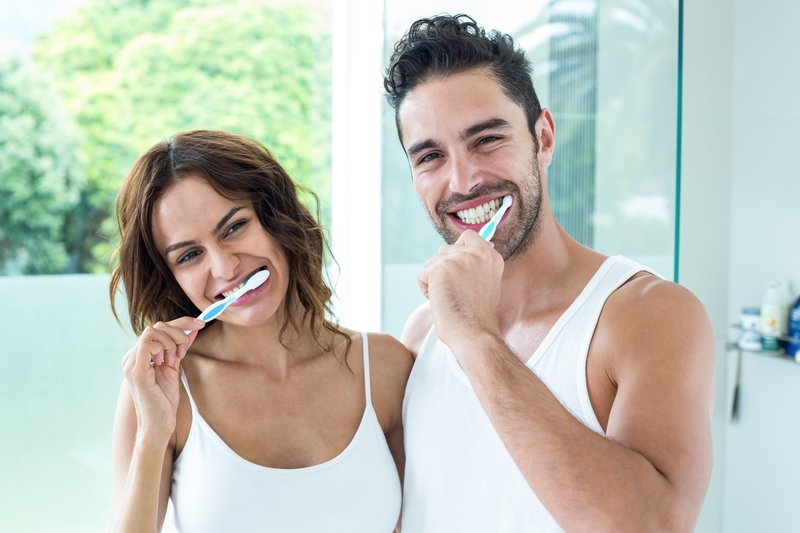
Braces can keep your teeth straighter, making them more beautiful and attractive. However, if your teeth cleaning habits are poor, your smile will take a hit. How well you take care of your teeth before and during braces will be an indication of how your smile will be after your orthodontic care has come to an end. If you don’t brush and floss the teeth enough, you might damage your smile and weaken your enamel. You must step up your cleaning routine during braces to make sure your smile isn’t full of cavities and oral health problems at the end of your care. We can give you the proper recommendations and guidelines to ensure you keep your smile healthy and strong during your time with braces and throughout life.
Brushing With and Without Braces
The American Dental Association recommends brushing and flossing the teeth at least twice a day to keep your mouth healthy and to lower your risk for tooth decay and gum disease. We go beyond that twice-a-day recommendation and suggest that you brush your teeth after every meal. Because your braces can easily attract and trap food particles, brushing after each meal can help prevent staining and reduce the potential for bacteria buildup.
You should use a soft-bristled brush and use one that’s size fits your mouth well. For teeth without braces, the ADA recommends brushing the teeth at a 45 degree angle. Brush each individual tooth, making sure to go all the way up to the gumline. You use a soft-bristled brush to avoid irritating the gums and eroding your tooth enamel. With braces, you want to brush down from the top, then up from the bottom on each tooth with a bracket. This will help dislodge food particles that have become trapped inside the brackets, which is extremely easy to do. Brushing your teeth multiple times a day is one of the best cleaning habits for avoiding decay.
Flossing the Teeth
We recommend flossing your teeth at least once a day. However, that’s for patients that don’t have braces. When you have braces, it’s even more important to floss each and every tooth. It’s also much more time consuming, but the effort you put into your teeth cleaning habits will pay off in the long run. A toothbrush and mouthwash simply can’t get in between the teeth like floss can, so if you skip flossing, you could have food sit and decay your teeth.
You will have to use threadable floss or a floss threader to accomplish this feat with brackets. If you use a floss threader for your teeth, think of your cleaning habits like you’re sewing. You floss the eye of the threader through your teeth and below the archwire. Then you floss the space, pull it out and thread once more. Make sure you don’t apply force or pressure against the archwire as you do this. For some patients, it may take about 10 minutes to floss, but it’s worth taking the time to avoid tooth decay.
Caring for Braces
Caring for your teeth becomes trickier with braces. You will find that you have to devote some extra time to caring for your braces, as you know have about 32 teeth that all have brackets that can collect food. During your time with braces, it is particularly important to maintain good oral health through attention to proper oral hygiene and cleaning habits. If you don’t, you could have your braces removed only to find that many of your teeth have areas of tooth decay. You could also be left with demineralization that leaves marks on all your teeth where the brackets were.
When it comes to caring for your braces, it’s not only important to clear away food particles that are on the teeth, but to be careful of what foods you put into your mouth. To avoid damage to your braces and your teeth during orthodontic treatment, you want to avoid hard foods, sticky foods, and foods high in sugar. This means you should avoid eating foods such as hard candy, chips, ice, apples, nuts, popcorn, carrots, corn on the cob, gum, caramel, taffy, licorice, gummies, and similar foods. Prevention is always key for avoid oral health issues!
Proper Teeth Cleaning Habits
If you’re going to spend 18-24 months straightening your teeth, you might as well keep those teeth healthy so they look nice at the end of your treatment. Brush your teeth every single day, multiple times a day. Floss as well and be meticulous with your cleaning habits. The better care you take of your braces while they’re on, the more you’ll enjoy your smile when they come off. If you would like help with your cleaning habits or tips, call our Belmar Orthodontics office today at (303) 225-9016!
Receiving Dental Care with Braces
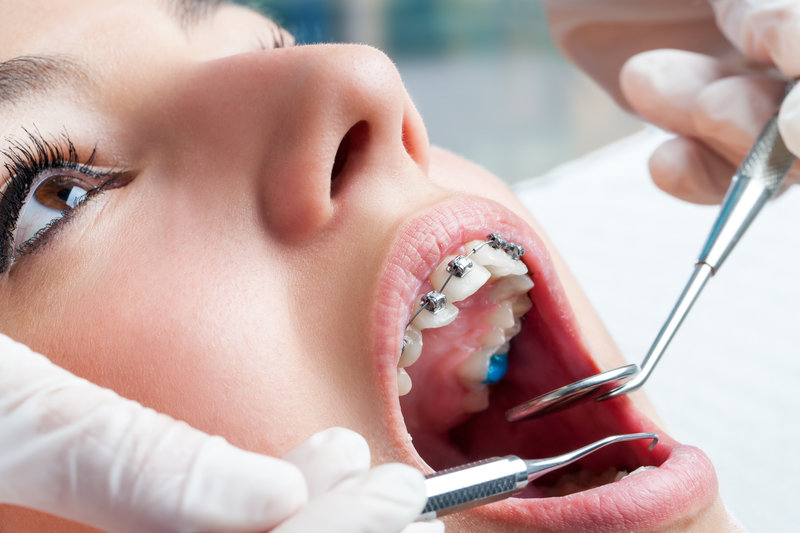
Dentist hands working on young teen patient with dental braces.
Should you receive dental care with braces or is seeing the orthodontist sufficient? Continue regular checkups with your dentist even if you are frequently seeing your orthodontist. Braces make you more prone to problems such as plaque buildup and tartar. Depending on the kind of braces you choose, your teeth may require additional steps to stay clean with braces than without. For some, the enamel can also weaken with braces. However, there are ways to keep your teeth healthy and clean while you have braces. Modern-day orthodontics offers treatment options everyone can be comfortable with and will still allow patients to receive proper dental care at the same time. We can answer frequently asked questions for receiving dental care with braces and help you with tips for taking care of your braces so your smile stays healthy.
Dentists and Orthodontists
Did you know that orthodontists attend dental school just like dentists do? Dentists and orthodontists are similar in their schooling up to a point. However, although both professions deal with the health of your teeth, they both do separate services. Dentists perform services such as:
- Comprehensive exams and diagnostic x-rays
- Dental cleanings
- Oral cancer screening
- Laser tissue treatment
- Periodontal treatment/Scaling and root planing
- Dental sealants
- Cavity fillings/Tooth colored fillings
- Sedation dentistry
- Porcelain veneers and crowns
- Cosmetic bonding
- Dental bridges and dental implants
- Root canal therapy
- Teeth whitening
An orthodontist performs other services different than a dentist, although they are skilled in dental practices. Orthodontists receive 4 years of undergraduate education, where they then attend dental school for 4 years. After dental school, they attend a postdoctoral program to learn orthodontia. A dentist fixes problems with your teeth in general, while an orthodontist fixes problems with teeth alignment as well as your bite and jaw alignment. Basically, every orthodontist is a dentist, but not every dentist is an orthodontist. Patients benefit from having both a dentist and an orthodontist to maintain a healthy mouth.
Caring for Your Teeth
Taking care of your teeth is a bit different with braces than it was without them. During your orthodontic treatment, it is particularly important to maintain good oral health through proper oral hygiene. Brackets and wires in your mouth make it much easier for food particles to get stuck. When those food particles are not removed, it leads to other dental issues like tooth decay (cavities) and gum disease. Your teeth may also demineralize or erode in the areas where your brackets were attacked to the teeth. Areas on the enamel surface lose minerals in this case, which is what causes white squares to form on the teeth. If you drink beverages that stain the teeth easily, you might be left with uneven stains once the brackets have been removed.
With braces, you should still follow the American Dental Association’s recommendation to brush the teeth at least twice a day. We recommend that you brush the teeth much more than that, as food particles can get stuck in the brackets at every single meal. Make sure to avoid hard foods like hard candies, chips, apples, nuts, popcorn and more with your brackets. Also avoid sticky foods such as gum, caramel, taffy, tootsie rolls, and gummies as these foods are much harder to get out of all the small areas of your braces. A lot of caring for your braces is watching what you eat and then cleaning the teeth often after you do eat.
Cleaning with Braces
Flossing is one of the daily tasks that will be more difficult with braces because there is an archwire that blocks the floss from going in and out of the spaces between the teeth with ease. The solution for this is to use threadable floss or a floss threader. With a floss threader, you use regular floss and thread it through the eye of the threader much like you would with a sewing needle and thread. You then floss the threader between each tooth individually. Floss that comes threadable will be harder at one end and will be able to be threaded between the teeth without having to have a separate threader.
After brushing with a toothbrush, you can also use a proxabrush, which looks like a small Christmas tree brush. You place this proxabrush between two brackets, below the archwire, and you brush up and down. This will get food that is hard-stuck in your brackets. Brushing after every meal will reduce how much food gets into your bracket and stays there.
Dental Care with Braces
Even though you are seeing an orthodontist frequently, you must continue to visit your dentist throughout your care! An orthodontist will get your teeth straight, but you receive dental cleanings, comprehensive exams, and cavity care from a dentist, not an orthodontist. Both professions deal with the teeth, but they both deal differently with the teeth. Only a dentist can find cavities and fill them for you. A dentist can provide all the services we listed above, which are all very important to keep the teeth healthy. Receiving frequent dental exams and cleanings are some of the best dental services you can receive while wearing braces, because keeping the teeth clean and free of cavities will help your smile be that much more beautiful in the end.
Schedule a Dental Visit
Your tooth enamel can suffer permanent damage if you don’t take extra care with your teeth with braces. That’s why it’s even more important to receive dental care while you have braces. Be vigilant with your oral hygiene every single day. Don’t skip days! You are spending months of your life to receive a straighter smile. You want that smile to also be a beautiful one at the end of your treatment. In the end, it is very important to receive dental care during braces and to take care of them yourself every day at home. If you have questions about caring for your braces, call our Belmar Orthodontics office today at (303) 225-9016.
How Do Adult and Child Orthodontics Differ?

Advancements in adult and child orthodontics have triggered a rise in adults seeking treatment for oral challenges they have had for years. When deciding to pursue orthodontic treatment, understanding the differences between adult and child orthodontics can help you decide what type of treatment is right for you. Everyone should want their best smile. Feeling confident about your teeth and smile is essential for healthy self-esteem and confidence. You can achieve both of those benefits with braces.
Benefits of Braces
For years, braces have helped millions of people receive a more beautiful smile. About 4 million Americans on average each year are wearing braces. You may think that braces are mostly for teenagers, but you may be surprised to know that about 25% of braces wearers are actually adults. A large portion of those 4 million are also children. Braces benefit people of all ages and it’s never too late to get your own set. Why are braces so important? Straighter teeth keep the mouth in proper alignment and help even out the pressure placed on the jaw each time you talk, bite, eat and more. When the teeth are straighter, they are easier to clean, especially to floss in between the teeth. This is why people with straighter teeth have a reduced risk for oral health problems such as tooth decay and gum disease.
Tooth Decay and Gum Disease
The biggest oral health problems are tooth decay and gum disease. These problems come from lack of good oral hygiene habits. If you skip on brushing and flossing the teeth (or not doing them enough) you may start to have problems. When food sits on the teeth, the sugars from the food you ate (or drank) mix with bacteria in the mouth. This mixture creates a sticky acidic substance called plaque. That plaque works hard to erode your tooth enamel. If it sits on the teeth long enough without being cleaned through brushing or flossing, it will seep into the center of your tooth, called the pulp. This is where that acidic plaque will start to decay your tooth. If left untreated, the problem can become severe. Tooth decay is the most wide-spread childhood disease.
Gum disease is similar to tooth decay, but it has to do with the gums. Plaque is not your friend in this case either. When it sits on the teeth for too long, it can irritate the gums. You may notice your gums begin to turn more red and they may become inflamed. Over time, if good oral hygiene habits are not established, the gums will begin to recede from the teeth. This can eventually cause the teeth to begin falling out. About 64.7 million American adults suffer from some form of gum disease. That’s not even including the number for children! Even though tooth decay and gum disease are so wide-spread, they can both be prevented by brushing and flossing several times a day and by establishing and keeping good oral hygiene habits.
Child Orthodontics
One area we specialize in is child orthodontics. A large portion of the people that wear braces are children. The American Association of Orthodontics recommends that children have their first orthodontic visit between ages 7 and 8. Having an examination early-on helps prevent the progression of orthodontic issues that may be present. In children, we can detect certain orthodontic problems—such as underbite or crossbite—that are present. These problems can be fixed with child orthodontics and other bite and alignment problems such as overbite, openbite and malocclusion. The jaw is still forming in children, so performing child orthodontics at this age can help easily correct problems that are harder to deal with as an adult. Even if your child does not show any signs or symptoms of orthodontic complications, you can still benefit from child orthodontics. Some benefits include:
- Monitoring the facial and jaw development
- Observing the progress of incoming teeth
- Guiding incoming teeth into their proper positions
- Reducing the risk of impacted teeth
- Decreasing the risk for permanent tooth extractions
- Detecting hidden dental issues
Adult Orthodontics
Adult and child orthodontics are very similar. However, it often takes longer to correct bite and alignment problems in adults than it does children or teenagers. This is because the jaw and mouth has stopped growing by adulthood. If bite or alignment problems are severe, an adult may have to look into receiving surgery to correct the problem. Adults also have a few more options when it comes to what kind of braces they would like. Adults and teenagers have the option to choose these types of braces besides traditional metal braces:
- Lingual Braces – These are also known as “Incognito” braces. They are a hidden braces apparatus on the tongue-side of your teeth. Worn on the inside, no one will even know you are wearing braces.
- Invisalign Transparent Aligners – This is a series of removable transparent aligners that are custom-made for your teeth. They can be removed for activities such as eating, drinking, sports and more. Because they are transparent, they are also a secret way for adults and teenagers to discreetly straighten their teeth.
- Clear Ceramic Braces – Made of ceramic material, these braces fit in with the color of your natural teeth. Ceramic material helps reduce the risk for demineralization and staining.
Your New Smile
Whether you are an adult or child, it’s never too late to improve your smile! For people of all ages, a straight smile boosts confidence and self esteem. For adults, that new smile of yours could help you land a job. Studies have also shown that straighter smiles make you appear more confident, successful, attractive and even more trustworthy to others. The benefits of braces are just too good to pass up! If you would like a new smile today, call our Belmar Orthodontics office at (303) 225-9016!
Why You Need Professional Orthodontic Care
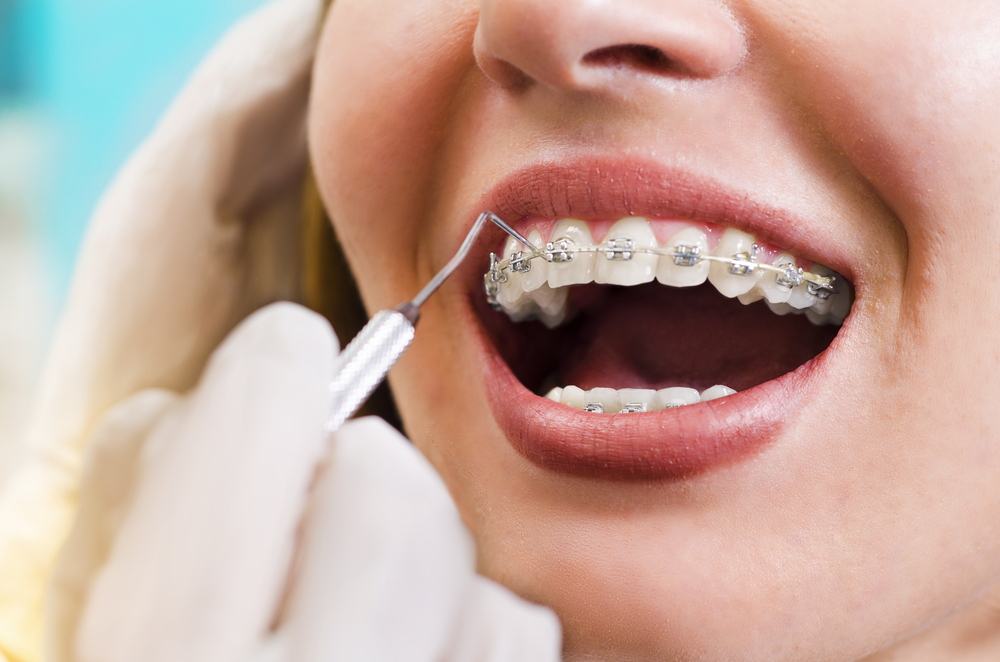
Why is professional orthodontic care so important? The economy has fluctuated from good times to bad times over and over in the last couple of decades. Some people try to cut corners when it comes to achieving healthy smiles by straightening their teeth themselves. Do “cutting corners” and “healthy” go hand-in-hand? Not at all! Only a professional orthodontist is trained to provide you a completely healthy and straight smile that you can’t get anywhere else. Proper orthodontic care can ensure that your teeth stay healthy and free from gum disease, tooth decay and tooth loss. It will also ensure that your teeth move appropriately so that your bite, alignment and function work the way they were designed to. At Belmar Orthodontics, we can provide you a smile that you will cherish the rest of your life. Find out why professional orthodontic care is worth the time, money and effort to achieve a wonderful smile.
Cutting Corners On Your Oral Health
We all know that problems will arise if proper oral hygiene habits aren’t followed. That includes brushing and flossing several times a day (after every meal if possible), seeing your dentist and orthodontist as needed, and making sure the teeth stay clean, straight and healthy in general. You would never want to save some time by cutting out brushing your teeth altogether right? How about flossing? Or maybe never seeing a dentist? There are major problems that can arise from choosing to cut corners on your oral health. Some of the main problems are gum disease and tooth decay that can literally rot your teeth out.
Gum Disease
Gum disease affects over 64.7 MILLION American adults. That means that there are many millions of Americans not taking proper care of their teeth. What does gum disease cause? It begins with gingivitis, or a buildup of sticky bacteria-filled plaque that coats the teeth and irritates the gums. Without cleaning the teeth often enough, the gums will begin to become red, inflamed and even bleed frequently. Skipping on the hygiene will make gingivitis more severe until it becomes full-blown gum disease, also known as periodontitis. At this stage, the gums will recede and the teeth can literally fall out. Yikes! Nobody wants that right?
Tooth Decay
Tooth decay is a problem that’s not far behind gum disease. It also has its beginnings when a person chooses to skip on their oral hygiene practices and keeps doing it. That sticky plaque that coats your enamel is a mix of bacteria and sugar that is actually an acidic substance. The acid will erode your hard tooth enamel and eventually seep into the soft center of your tooth where it will accelerate tooth decay.
Do-It-Yourself-Orthodontics
Gum disease and tooth decay are both serious conditions that you want to avoid at all costs. You only get one set of teeth, so the goal should always be to keep them healthy, right? Cutting corners (even simply skipping cleaning the teeth) causes major damage to your oral health. Do-it-yourself-orthodontics is a new trend that has popped up on the scene. ABC news reported on this trend and how damaging it can be to your oral health. Many people wanted to cut corners with proper orthodontic care and do their own straightening at home using crude methods with rubber bands, fishing line, paper clips and any other material you could think of.
Not surprisingly, many patients (especially adolescents) who attempted to do their own orthodontic care damaged their teeth “so extensive[ly] that teeth cannot be saved.” That comes straight from the president of the American Association of Orthodontists. Do-it-yourself methods of orthodontics are bound to lead to many more oral health problems than you could have ever imagined. So far, it has proved to be disastrous for those who attempt to cut corners. Remember, cutting corners on your health is just that…cutting corners. Nobody comes out a winner.
Proper Orthodontic Care
When you only have one set of pearly whites, why take a chance on losing them? Orthodontists must extensively train for years and attend dental school. They then take an additional 2-3 EXTRA years to study orthodontic practices and how to keep your mouth the healthiest it can be. You get what you pay for and if that’s trying to straighten your own teeth with fishing line, you can bet that you’ll have a low-quality results. With professional orthodontic care, you’re going to get a professional and effective experience. Plus, you’ll actually save yourself time, money and risk of disaster by investing in orthodontic care the proper way.
The cool thing about our orthodontic office is that we offer more than just traditional metal braces. If you want to straighten your teeth more discreetly (or not have anyone know), we have Invisalign transparent aligners, lingual braces, ceramic clear braces, retainers and more. At Belmar Orthodontics, you can be sure to get a beautiful, straight smile AND keep all of your teeth healthy and strong for years to come. Simply call our office at (303) 225-9016 for your free consultation!
Why Having Good Oral Hygiene Is Important
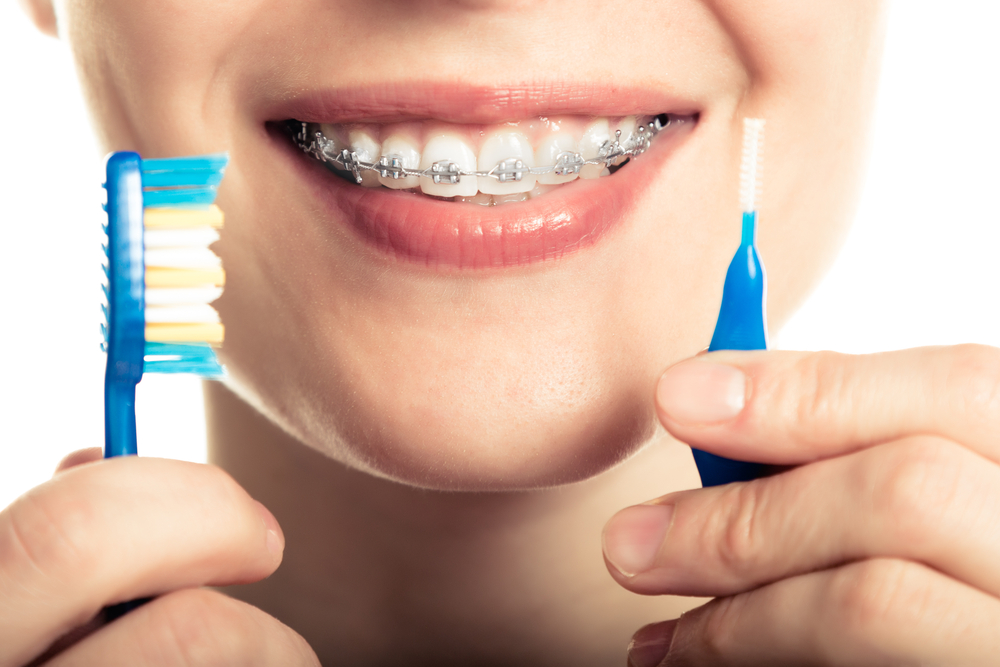
Millions of Americans don’t practice good oral hygiene, which is the #1 reason teeth decay and fall out. Good oral hygiene coupled with good nutrition can help prevent gum disease, tooth decay and even bad breath. It will also help us to be able to straighten your teeth without damage and provide you with a more brilliant, beautiful smile. There are many tips for keeping your teeth healthy and strong. Many of these tips have to do with nutrition and overall good oral hygiene. Good nutrition can aid in better health for you and for your teeth. We want all of our patients to be able to achieve a healthy mouth, but the first steps begin before you even come to our office. At Belmar Orthodontics, learn more about good oral hygiene and how orthodontic care can help you!
Practice Good Oral Hygiene
Sometimes, the basics are the hardest to do because they seem so simple. You skip brushing one night, then you do it again, and soon it starts to become a habit. When it comes to braces, we see patients skip on the basics here and there all the time. Why? This is most likely because braces take a little bit longer to care for than teeth without braces. Skipping on proper brushing and flossing can seriously damage and erode the tooth enamel.
The Prevalence of Decay
We recommend brushing and flossing at least twice a day, if not more. After every meal would be ideal, but not everyone makes a habit of doing that. What happens when you don’t brush and floss the teeth properly? You develop dental caries. The American Dental Association reports that 91% of adults 20 years old and older have had dental caries. 27% had untreated tooth decay. What does this mean? It means that 91% of people have had cavities and 27% had untreated cavities that will continue decaying. The National Institute of Dental and Craniofacial Research reports that dental caries is the most prevalent chronic disease in the United States in both children and adults. The sad part? It’s completely preventable.
Tooth decay occurs when proper oral hygiene practices are not followed. When we eat and drink, bacteria in the mouth mixes with sugar to make acidic plaque. That plaque coats your teeth and over time, erodes the hard tooth enamel. Inside the tooth is a soft, pulpy center that contains nerves and sensitive parts of the tooth. When hygiene practices are skipped, that plaque will erode the teeth enough to break down the enamel and seep into the soft, pulpy center. It will then have a heyday and cause as much decay as it possibly can. Mild tooth decay will result in fillings for cavities. Severe tooth decay will result in a root canal or a dental extraction. The great part about all of this? Tooth decay is completely preventable! All you have to do is take care of your oral health!
Be Extra Careful with Braces
Braces make cleaning the teeth slightly more tricky, but definitely not impossible! With braces, you generally have brackets that are glued to each tooth. A wire connects those brackets on the upper and lower jaws. Brackets and wires in your mouth make it easier for food particles to get stuck. This leads to other dental issues if proper care is not taken. Here are some tips to help prevent tooth decay:
- Brush after every meal. Brushing will help prevent staining and will reduce the potential for bacteria buildup. Food can easily become trapped in the brackets and can erode the tooth enamel around the brackets. Make sure to use a soft brush to brush down from the top, then up from the bottom on each bracket and tooth.
- Use a floss threader. You can’t skip flossing when it comes to braces as it’s even more important now than ever. Tooth decay often happens between the teeth with braces. Using a floss threader will allow you to insert the floss through the teeth and above or below the wire. This allows you to clean effectively in between each tooth. Do this several times a day!
- Avoid certain foods. Hard foods are a no-no with braces and can break brackets or become stuck in the teeth. Avoid hard candy, chips, ice, apples, crusty bread, nuts, popcorn, corn on the cob, carrots and any other hard candies. Avoid chewy candies or foods such as caramel, toffee, taffy, starbursts, licorice, tootsie rolls, gummy bears and more. For a more comprehensive list of food items, you can always call our office.
Over 64 million Americans suffer from gum disease, tooth loss and tooth decay. Poor dental hygiene and tooth decay make orthodontic care that much harder to perform. The point is to get your smile straight and beautiful without making it weaker. Our orthodontic techniques are effective and strong when it comes to getting your teeth in proper position. We want all our patients to have beautiful, straight and strong smiles. It’s vital that you follow proper oral hygiene practices every single day and that you double your efforts while wearing braces. If you need help with your oral hygiene routine or braces maintenance, call our Belmar Orthodontics office today at (303) 225-9016.

